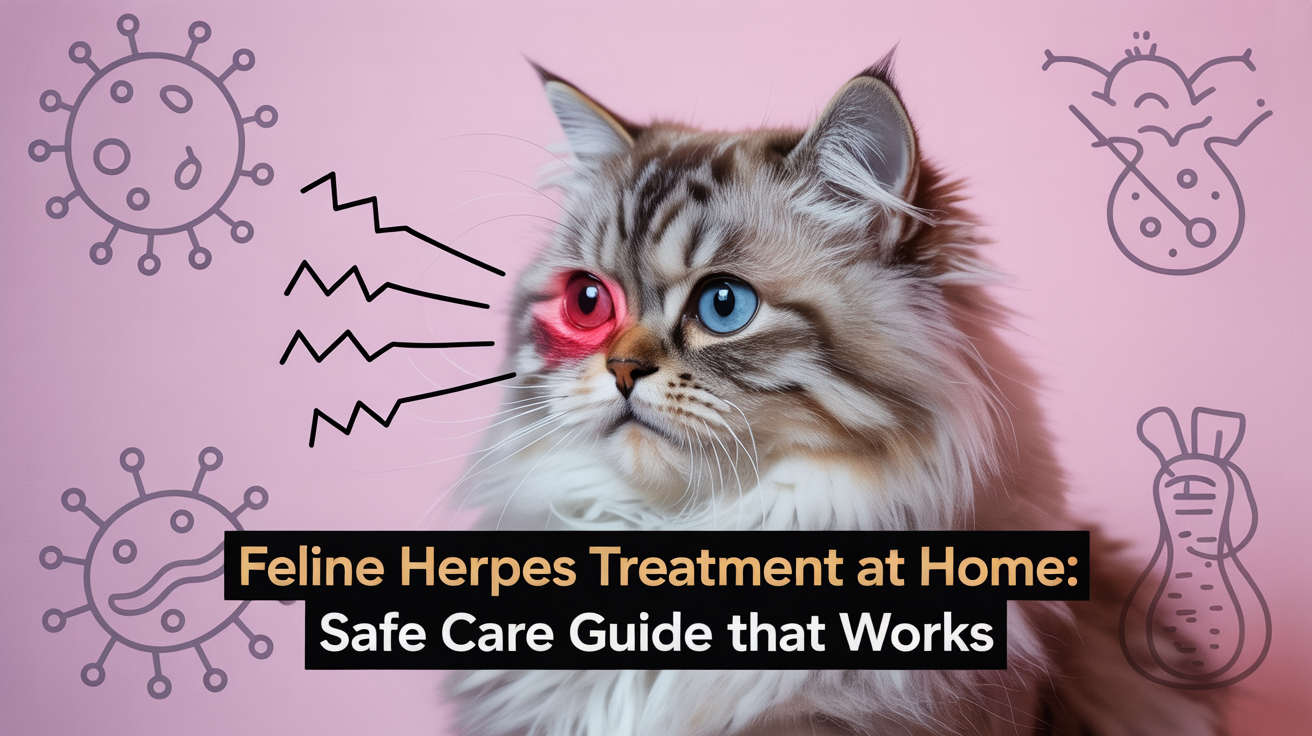
Feline Herpes Treatment at Home: Safe Care Guide That Works
Managing feline herpes at home requires understanding the difference between supportive care and medical treatment that only veterinarians can provide. After helping manage feline herpes outbreaks in seven rescue cats and my own two cats over six years, I’ve learned which home care measures genuinely help and which approaches can actually make symptoms worse.
The essential answer: Home treatment for feline herpes focuses on supportive care including humidification, gentle eye cleaning, stress reduction, and immune support under veterinary guidance. However, antiviral medications and treatment of secondary infections require professional veterinary care.
Most cats with feline herpes benefit significantly from consistent supportive home care, but the condition cannot be cured and requires lifelong management with periodic veterinary oversight.
Important Medical Disclaimer: This information is for educational purposes only and does not replace professional veterinary care. Always consult your veterinarian before starting any treatment regimen. Feline herpes can cause serious complications including corneal ulcers and secondary bacterial infections that require immediate professional attention.
Understanding Feline Herpes and When Home Care is Appropriate
Feline herpes virus (FHV-1) affects up to 90% of cats and causes recurring respiratory and eye symptoms throughout a cat’s lifetime. Unlike human herpes, this virus cannot be transmitted to humans, but it spreads easily between cats through direct contact and respiratory droplets.
In my experience managing herpes-positive rescue cats, I’ve observed that stress, illness, or environmental changes typically trigger outbreaks. My rescue cat Luna consistently develops mild eye discharge and sneezing during household disruptions, while another cat, Smokey, shows more severe symptoms requiring veterinary intervention.
Home care becomes appropriate for managing mild to moderate symptoms and supporting your cat’s immune system between veterinary visits. However, severe symptoms including thick eye discharge, appetite loss, or breathing difficulties always require immediate professional attention.
The key is recognizing that feline herpes management involves controlling symptoms and supporting comfort rather than eliminating the virus, which remains dormant in nerve tissue and can reactivate throughout your cat’s life.
Safe Home Treatments and Supportive Care Measures
Humidification and Environmental Management
Increased humidity helps loosen respiratory secretions and reduces eye irritation during herpes outbreaks. I use a cool-mist humidifier in rooms where affected cats spend most of their time, maintaining humidity levels between 40-50%.
Steam therapy provides immediate relief for congested cats. Run hot water in your bathroom sink or shower to create steam, then sit with your cat in the steamy room for 10-15 minutes twice daily. Always supervise this process and ensure your cat can leave if uncomfortable.
Air purifiers remove irritating particles that can worsen respiratory symptoms. Choose models with HEPA filters and avoid ionizing purifiers that may irritate sensitive respiratory systems.
Temperature consistency prevents additional stress that can trigger outbreaks. Maintain comfortable room temperatures between 68-72°F and avoid drafty areas where affected cats rest.
Gentle Eye and Nasal Care
Warm compresses help remove dried discharge and provide comfort for irritated eyes. Use clean, warm water on a soft cloth, applying gentle pressure for 30-60 seconds per eye. Replace the cloth between eyes to prevent cross-contamination.
Saline eye rinses remove debris and provide moisture for dry, irritated eyes. Use sterile saline solution (never tap water) in a clean dropper, applying 1-2 drops per eye as needed. Commercial pet eye washes designed for cats also work well.
Nasal cleaning requires extreme gentleness since cats resist facial handling. Use a warm, damp cloth to softly remove discharge from around nostrils, never attempting to insert anything into nasal passages.
Cotton swabs should never be used around cat eyes or noses, as they can cause injury if the cat moves suddenly. Stick to soft cloths and gentle techniques.
Nutritional Support and Immune System Enhancement
L-lysine supplementation may help reduce outbreak frequency and severity in some cats. I’ve used lysine supplements with mixed results – some cats show noticeable improvement while others show no change. Always consult your veterinarian about appropriate dosing.
High-quality nutrition supports immune function during outbreaks. Choose foods with easily digestible proteins and avoid unnecessary additives that might stress compromised systems. Wet food provides additional moisture that benefits cats with respiratory symptoms.
Appetite stimulation becomes important when herpes affects taste and smell. Warming food slightly enhances aroma and encourages eating. If your cat stops eating for more than 24 hours, contact your veterinarian immediately.
Fresh water availability ensures proper hydration essential for immune function and respiratory health. Clean water bowls daily and consider water fountains that encourage drinking.
Stress Reduction and Environmental Stability
Routine maintenance helps prevent stress-triggered outbreaks. Keep feeding times, litter box cleaning, and daily activities as consistent as possible during and after outbreaks.
Quiet spaces allow affected cats to rest without stimulation that might worsen symptoms. Provide comfortable bedding in low-traffic areas where cats can recover undisturbed.
Pheromone therapy using Feliway diffusers can reduce environmental stress that triggers herpes outbreaks. I’ve noticed fewer severe outbreaks in multi-cat households using pheromone products consistently.
Gradual introductions of any changes help prevent outbreak triggers. Whether introducing new pets, moving furniture, or changing routines, make transitions slowly to minimize stress impact.
Recognizing When Professional Veterinary Care is Required
Emergency Symptoms Requiring Immediate Attention
Thick, colored eye discharge indicates secondary bacterial infection requiring antibiotic treatment. Clear discharge may be manageable at home, but yellow, green, or white discharge needs veterinary evaluation within 24 hours.
Breathing difficulties including open-mouth breathing, wheezing, or rapid respiratory rate require emergency veterinary care. These symptoms can indicate serious complications like pneumonia or severe upper respiratory obstruction.
Loss of appetite lasting more than 24 hours can lead to serious health complications, especially in cats with existing health conditions. Cats can develop hepatic lipidosis (fatty liver disease) quickly when not eating.
Eye ulcers appear as cloudy or white spots on the eye surface and require immediate treatment to prevent permanent vision damage. Never attempt to treat suspected corneal ulcers at home.
Progressive Symptoms Needing Professional Evaluation
Worsening symptoms despite home care indicate the need for veterinary intervention. If discharge increases, new symptoms develop, or your cat seems more uncomfortable after 48-72 hours of home treatment, seek professional help.
Recurring outbreaks happening more frequently or severely may require prescription antiviral medications. Some cats benefit from daily antiviral therapy to reduce outbreak frequency and severity.
Secondary infections often develop during herpes outbreaks, particularly bacterial infections in eyes, nose, or respiratory tract. These require antibiotic treatment that only veterinarians can prescribe.
Dehydration can develop quickly in cats with respiratory symptoms who aren’t drinking enough. Signs include sticky gums, skin tenting, and lethargy requiring professional fluid therapy.
Creating a Comprehensive Home Care Plan
Daily Monitoring and Documentation
Temperature tracking helps identify fever that might indicate secondary infections. Normal cat temperature ranges from 100.4-102.5°F. Temperatures above 103°F require immediate veterinary attention.
Symptom journaling allows you to track patterns and identify triggers for your cat’s outbreaks. Note environmental changes, stress factors, and which treatments seem most effective.
Appetite monitoring ensures early intervention if eating decreases. Weigh food portions and document consumption to track changes that might indicate worsening illness.
Activity level changes often signal illness progression or improvement. Cats feeling better gradually return to normal play and interaction patterns.
Medication Management for Prescribed Treatments
L-lysine administration requires consistent timing and dosing when recommended by your veterinarian. Most cats receive 250-500mg twice daily, but dosing should always be veterinary-guided.
Antiviral medications like famciclovir may be prescribed for severe or frequent outbreaks. These require precise dosing and monitoring for side effects including decreased appetite or vomiting.
Eye medications must be applied correctly to be effective. Learn proper restraint techniques and application methods from your veterinarian to ensure successful treatment.
Antibiotic compliance becomes crucial when secondary infections develop. Complete the entire prescribed course even if symptoms improve to prevent antibiotic resistance.
Environmental Modifications for Long-Term Management
Isolation protocols help prevent transmission to other cats during active outbreaks. Use separate food bowls, litter boxes, and bedding for affected cats until symptoms resolve.
Cleaning routines should include daily disinfection of food bowls, litter boxes, and frequently touched surfaces. Use pet-safe disinfectants that kill viruses without creating harmful residues.
Air quality improvements include regular HVAC filter changes, avoiding aerosol products, and maintaining optimal humidity levels year-round.
Multi-cat household management requires careful monitoring since stress in one cat can trigger outbreaks in others. Provide adequate resources and space to minimize competition and stress.
Preventive Strategies and Immune Support
Vaccination and Preventive Medical Care
Core vaccinations help prevent severe herpes complications, though they don’t prevent infection entirely. Maintain current vaccinations according to your veterinarian’s recommendations.
Regular veterinary checkups allow early detection of health issues that might compromise immune function and trigger herpes outbreaks. Annual or bi-annual exams help maintain optimal health.
Parasite prevention supports immune system function by reducing the burden of fighting multiple infections simultaneously. Keep cats current on flea, tick, and worm prevention.
Dental care prevents oral infections that can stress the immune system and potentially trigger herpes outbreaks. Regular dental cleanings and home dental care support overall health.
Lifestyle Factors Supporting Immune Health
Exercise appropriate for your cat’s age and health status supports immune function. Indoor cats benefit from interactive play sessions and climbing opportunities.
Weight management prevents obesity-related immune suppression that can worsen herpes symptoms. Maintain ideal body condition through proper nutrition and portion control.
Sleep quality affects immune function significantly. Provide quiet, comfortable sleeping areas away from household disruptions.
Mental stimulation through puzzle feeders, interactive toys, and environmental enrichment reduces stress that can trigger outbreaks.
Cost Considerations for Home and Veterinary Care
Budget-Friendly Home Care Options
Basic supportive care including humidification, gentle cleaning, and stress reduction costs very little but provides significant benefit. A cool-mist humidifier ($30-50) and pet-safe eye wash ($10-15) cover most basic needs.
L-lysine supplements range from $15-30 per month depending on brand and dosing. While not definitively proven effective, many owners report reduced outbreak severity with consistent use.
Environmental modifications like pheromone diffusers ($25-40 initial cost, $15-20 monthly refills) may reduce outbreak frequency by managing stress levels.
DIY humidification using bathroom steam therapy costs nothing but requires time and supervision to ensure safety.
Professional Care Investment Planning
Initial veterinary diagnosis including examination and potential diagnostic tests typically costs $100-300. This establishes baseline health and rules out other conditions with similar symptoms.
Prescription medications for severe outbreaks can range from $50-200 depending on type and duration of treatment. Antiviral medications are more expensive than supportive treatments.
Emergency visits for complications like corneal ulcers or severe respiratory distress can cost $300-800 or more. Early intervention often prevents these expensive complications.
Ongoing management with regular checkups and preventive care costs $200-400 annually but often prevents more expensive crisis interventions.
Building a Support Network for Long-Term Management
Working Effectively with Your Veterinary Team
Communication strategies help ensure optimal care coordination. Prepare questions in advance and bring documentation of symptoms and treatments tried at home.
Emergency protocols should be established before crises occur. Know when your veterinary clinic is available and have emergency clinic contact information readily accessible.
Follow-up scheduling helps track treatment effectiveness and adjust care plans as needed. Don’t wait for severe symptoms to schedule rechecks.
Second opinion considerations may be appropriate for cats with frequent severe outbreaks that don’t respond well to standard treatments.
Connecting with Other Cat Owners
Online support groups provide valuable insights from experienced cat owners managing feline herpes. However, always verify advice with your veterinarian before implementing suggestions.
Local cat rescue organizations often have extensive experience managing herpes-positive cats and may offer practical advice and resources.
Veterinary technician consultations can provide additional guidance on home care techniques and symptom monitoring between veterinary visits.
Educational resources from veterinary colleges and professional organizations offer science-based information about feline herpes management.
Frequently Asked Questions
Can feline herpes be completely cured with home treatment?
No, feline herpes cannot be cured with any treatment, home or professional. The virus remains dormant in nerve tissue for life and can reactivate during stress or illness. Home treatment focuses on managing symptoms and supporting comfort during outbreaks. While some cats experience fewer and milder outbreaks with consistent supportive care, the virus itself cannot be eliminated from their system.
How long do herpes outbreaks typically last with home care?
Most mild to moderate feline herpes outbreaks resolve within 7-14 days with appropriate supportive care. Severe outbreaks or those complicated by secondary infections may last longer and require veterinary intervention. Consistent home care including humidification, gentle cleaning, and stress reduction can help shorten outbreak duration and reduce symptom severity. Contact your veterinarian if symptoms persist beyond two weeks or worsen despite home treatment.
Is L-lysine supplementation safe and effective for cats with herpes?
L-lysine is generally safe for cats when used at appropriate doses, but scientific evidence for its effectiveness in treating feline herpes is limited and conflicting. Some cats seem to benefit from lysine supplementation while others show no improvement. Typical dosing ranges from 250-500mg twice daily, but always consult your veterinarian before starting any supplements. Lysine should never replace proper veterinary care for severe symptoms.
When should I isolate my cat with herpes from other cats?
Isolate cats during active herpes outbreaks when they show symptoms like eye discharge, sneezing, or nasal discharge. The virus spreads through respiratory droplets and direct contact, so isolation prevents transmission to other cats. Provide separate food bowls, litter boxes, and bedding during symptomatic periods. Cats can return to normal interaction once symptoms resolve, though they may still shed virus intermittently even when asymptomatic.
Can stress really trigger feline herpes outbreaks, and how can I minimize this?
Yes, stress is a major trigger for feline herpes outbreaks because it suppresses immune function and allows the dormant virus to reactivate. Common stressors include household changes, new pets, travel, illness, or routine disruptions. Minimize stress through consistent routines, adequate resources in multi-cat homes, pheromone therapy, and gradual introductions of any changes. Creating quiet retreat spaces and maintaining stable environments significantly reduces outbreak frequency in many cats.
Creating a Comprehensive Long-Term Management Strategy
Managing feline herpes at home successfully requires understanding that this condition involves lifelong care rather than short-term treatment. The most effective approach combines consistent supportive home care with appropriate veterinary oversight and realistic expectations about outcomes.
Success comes from recognizing early warning signs, implementing supportive measures quickly, and knowing when professional intervention becomes necessary. Many cats with herpes live comfortable, normal lives when their owners understand the condition and provide appropriate care.
Remember that every cat responds differently to herpes management strategies. What works well for one cat may not be effective for another, requiring patience and willingness to adjust care approaches based on your individual cat’s needs and responses.
The investment in learning proper home care techniques and building a good relationship with your veterinary team pays dividends in your cat’s comfort and quality of life. Early intervention and consistent supportive care often prevent the severe complications that make feline herpes a serious health concern.


